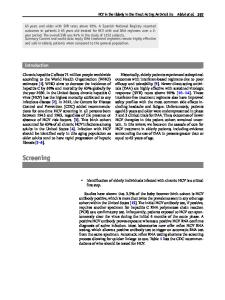Antiviral drugs against hepatitis C virus
- PDF / 575,686 Bytes
- 10 Pages / 595.276 x 793.701 pts Page_size
- 80 Downloads / 358 Views
GENETIC VACCINES AND THERAPY
REVIEW
Open Access
Antiviral drugs against hepatitis C virus Sidra Rehman†, Usman A Ashfaq*† and Tariq Javed
Abstract Hepatitis C virus (HCV) infection is a major worldwide problem causes acute and chronic HCV infection. Current treatment of HCV includes pegylated interferon-a (PEG IFN- a) plus ribavirin (RBV) which has significant side effects depending upon the type of genotype. Currently, there is a need to develop antiviral agents, both from synthetic chemistry and Herbal sources. In the last decade, various novel HCV replication, helicase and entry inhibitors have been synthesized and some of which have been entered in different phases of clinical trials. Successful results have been acquired by executing combinational therapy of compounds with standard regime in different HCV replicons. Even though, diverse groups of compounds have been described as antiviral targets against HCV via Specifically Targeted Antiviral Therapy for hepatitis C (STAT-C) approach (in which compounds are designed to directly block HCV or host proteins concerned in HCV replication), still there is a need to improve the properties of existing antiviral compounds. In this review, we sum up potent antiviral compounds against entry, unwinding and replication of HCV and discussed their activity in combination with standard therapy. Conclusively, further innovative research on chemical compounds will lead to consistent standard therapy with fewer side effects. Introduction HCV belonging to the family Flaviviridae signifies to be an entire global dilemma which parades the variability of genome translated into six genotypes and more than 80 subtypes. HCV has infected 200 million people worldwide [1], of which 10 million individuals (6% of the population) have been spotted in Pakistan [2]. HCV was firstly recognized in 1989 [3], comprising of 9.6 kb positive sense genome. It encodes a single polyprotein precursor of 3010 amino acids having an internal ribosome entry site at 5’ untranslated region (UTR), vital for the translation. This polyprotein precursor is co-translationally processed by cellular and viral proteases into three structural proteins (core, E1 & E2) and seven nonstructural proteins (P7, NS2, NS3, NS4A, NS4B, NS5A & NS5B) [4] (Figure 1). HCV infection is generally going to be clinically imperceptible after 3-12 weeks of incubation [5]. Currently, it is estimated that 50-80% of patients have successively infected with chronic infection and 2-5% have developed hepatocellular carcinoma per annum. HCV has the capacity to stimulate immunopathological effects, engendering reactive oxygen species (ROS) * Correspondence: [email protected] † Contributed equally Division of Molecular Medicine, National Centre of Excellence in Molecular Biology, University of the Punjab, Lahore, Pakistan
impend indirectly fibrogenetic effects [6] leading to steatosis and cirrhosis [7]. HCV infection commences while interaction of virions instigate with various cellular receptors [8]. After internalization of virions by cl
Data Loading...











